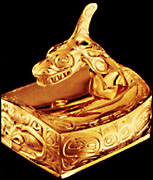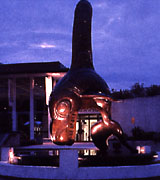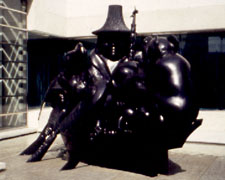| IN MEMORIAM: | (1920-1998) |
Biographical Notes
Upbringing and apprenticeship | Early work | Monumental works
Words and pictures | Bill Reid, 1920-1998 | His legacy
Monumental works
"He has reached much farther than Edenshaw into the well-lit, sensuous world of three-dimensional space, still without losing touch or breaking faith with the world of Haida myth and its iconographic tradition."
Robert Bringhurst, The Black Canoe: Bill Reid and the Spirit of Haida Gwaii, Vancouver: Douglas & McIntyre, 1991, p.42"Once we discard our ethnocentric, hierarchical ideas of how the world works, we will find that one basic quality unites all the works of mankind that speak to us in human, recognizable voices across the barriers of time, culture and space: the simple quality of being well made."
Bill Reid, from the introduction to a show of works by Bill Koochin at the Burnaby Art Gallery, 1980
Reid's work has been wide-ranging, in terms of materials and scale. Numerically, his smaller works -- especially his jewellery and boxes in silver or gold -- predominate, and some served as models for subsequent larger-scale works. In terms of making a living from his art, it was his silk-screen prints that were the principal source of his steady income. However, in the public eye he is best known for his massive sculptures and, in relation to his works in wood, has described his task as "an exercise in peeling away the outer layers to see what comes out." He had not intended, at the beginning of his career, to be creating monumental works of art; he always considered himself first and foremost a goldsmith, and a craftsman rather than an artist (while recognizing that craftsmanship and artistry must go hand in hand). Yet the later part of his career was marked primarily by the monumental sculptures commissioned for public locations.
 |
 |
|
| gold "box" (1971) based on the shape of serving dishes Royal British Columbia Museum cat.no.13902 |
Killer Whale (1984) Vancouver Public Aquarium |
In 1983-84 he was working on a sculpture of a Killer Whale commissioned for the Vancouver Public Aquarium; this was his first experience with bronze casting, although he had used the form of a leaping whale before, on another of his small gold boxes. From 1983-1986 he was busy designing and constructing two full-sized cedar canoes commissioned for Expo 86.
 |
 |
|
| Spirit of Haida Gwaii (1991) the "Black Canoe" Canadian Embassy, Washington photo: George MacDonald |
Spirit of Haida Gwaii (1994) the "Jade Canoe" Vancouver Airport photo: George MacDonald |
In 1986 he was commissioned to design a further monumental bronze sculpture, "The Spirit of Haida Gwaii", for the new Canadian Embassy in Washington, D.C., shortly after completing another of his better-known cedar carvings, "Phyllidula, the Shape of Frogs to Come" for the Vancouver Art Gallery. The latter, named after a character in an Ezra Pound poem who is described as "scrawny but amorous", extended the traditional form of the animal to its limit. The former, completed in 1991, was inspired initially by nineteenth century argillite carvings of the Haida, which is why the bronze was painted as black as possible. A jade-coloured cast was subsequently produced for installation in the Vancouver Airport, while the original white plaster-cast was acquired by the Canadian Museum of Civilization. Reid's lively bronze frieze "Mythic Messengers" (1984), commissioned for Teleglobe Canada's international centre in Burnaby, B.C. (with a duplicate installed at the Canadian Museum of Civilization), had been similarly inspired -- it is very reminiscent of an argillite panel pipe, but on a monumental scale and with greater fluidity of form and complexity of design.

Mythic Messengers
Canadian Museum of Civilization
LH991.2821.1
"The Spirit of Haida Gwaii" and "Mythic Messengers" exemplify the packing of many forms and figures into a confined space, resulting in a dynamic tension: the containment of energies that is an underlying principle of Haida art. The same approach is seen in an earlier work (1968): the cedar screen, "Legacy", carved for the Royal British Columbia Museum. These three sculptures also bring together some of Reid's favourites from the dramatis personae of Haida mythology, which he used repeatedly in his work: the Bear Mother and her family, the Sea Wolf, the Killer Whale, the Eagle, and of course the Raven.
 |
 |
 |